美英报刊阅读教程课文翻译
课文翻译 英美报刊阅读教程中级精选本 第五版 端木义万 Lesson20

Lesson 20 East Versus West东西方观念和思维的差异classmates chime in.同学插话。
That kind of collectivism confirms the commonly held belief that learning by organic induction is more effective than rote memorization.这种集体主义证实了有机归纳学习比死记硬背更有效的普遍信念。
Why do you find, in a music conservatory, a lot of Asian would-be concert pianists but comparatively few Asian opera-singers-in-training?为什么在音乐学院会有很多想成为钢琴家的亚洲人,而受训的亚洲歌剧演员却相对较少?There's a physical limit to how many hours a day a person can sing, Nisbett says, but not to how many hours one can practice sonatas.尼斯贝特说,一个人每天唱歌的时间有生理上的限制,但练习奏鸣曲的时间没有生理上的限制。
He attributes these differences to history.他将这些差异归因于历史。
East Asian agriculture was a communal venture in which tasks like irrigation and crop rotation had citizens acting in concert.东亚农业是一种公共事业,其中灌溉和作物轮作等任务需要公民协同行动。
In contrast, Western food production led to more lone-operator farmers and herdsmen. 相比之下,西方食品生产导致了更多的孤独的农民和牧民。
美英报刊阅读教程Lesson 2 课文
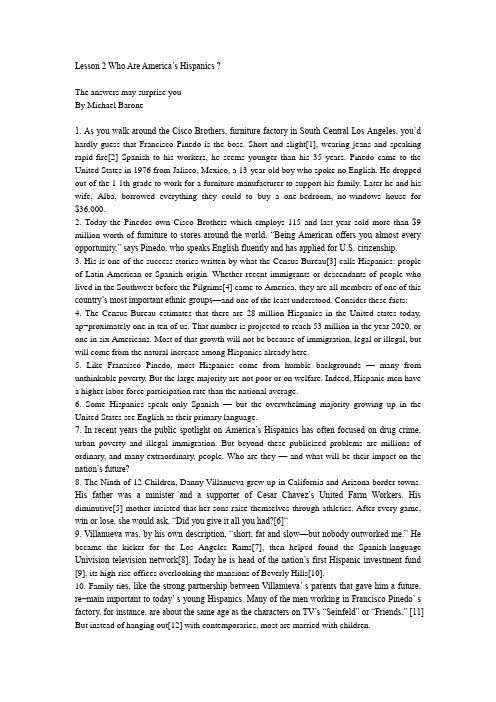
Lesson 2 Who Are America‟s Hispanics ?The answers may surprise youBy Michael Barone1. As you walk around the Cisco Brothers, furniture factory in South Central Los Angeles, you‟d hardly guess that Francisco Pinedo is the boss. Short and slight[1], wearing jeans and speaking rapid-fire[2] Spanish to his workers, he seems younger than his 35 years. Pinedo came to the United States in 1976 from Jalisco, Mexico, a 13-year-old boy who spoke no English. He dropped out of the 1 1th grade to work for a furniture manufacturer to support his family. Later he and his wife, Alba, borrowed everything they could to buy a one-bedroom, no-windows house for $36,000.2. Today the Pinedos own Cisco Brothers which employs 115 and last year sold more than $9 million worth o f furniture to stores around the world. “Being American offers you almost every opportunity,” says Pinedo, who speaks English fluently and has applied for U.S. citizenship.3. His is one of the success stories written by what the Census Bureau[3] calls Hispanics: people of Latin American or Spanish origin. Whether recent immigrants or descendants of people who lived in the Southwest before the Pilgrims[4] came to America, they are all members of one of this country‟s most important ethnic groups—and one of the least understood. Consider these facts:4. The Census Bureau estimates that there are 28 million Hispanics in the United states today, ap¬proximately one in ten of us. That number is projected to reach 53 million in the year 2020, or one in six Americans. Most of that growth will not be because of immigration, legal or illegal, but will come from the natural increase among Hispanics already here.5. Like Fransisco Pinedo, most Hispanics come from humble backgrounds —many from unthinkable poverty. But the large majority are not poor or on welfare. Indeed, Hispanic men havea higher labor-force participation rate than the national average.6. Some Hispanics speak only Spanish —but the overwhelming majority growing up in the United States see English as their primary language.7. In recent years the public spotlight on America‟s Hispanics has often focused on drug crime, urban poverty and illegal immigration. But beyond these publicized problems are millions of ordinary, and many extraordinary, people. Who are they — and what will be their impact on the nation‟s future?8. The Ninth of 12 Children, Danny Villanueva grew up in California and Arizona border towns. His father was a minister and a supporter of Cesar Chavez‟s United Farm Workers. His diminutive[5] mother insisted that her sons raise themselves through athletics. After every game, win or lose, she would ask, “Did you give it all you had?[6]“9. Villanueva was, by his own description, “short, fat and slow—but nobody outworked me.” He became the kicker for the Los Angeles Rams[7], then helped found the Spanish-language Univision television network[8]. Today he is head of the nation‟s first Hispanic investment fund[9], its high-rise offices overlooking the mansions of Beverly Hills[10].10. Family ti es, like the strong partnership between Villanueva‟ s parents that gave him a future, re¬main important to today‟ s young Hispanics. Many of the men working in Francisco Pinedo‟ s factory, for instance, are about the same age as the characters on TV‟s “Seinfeld” or “Friends.” [11] But instead of hanging out[12] with contemporaries, most are married with children.11. According to the most recent statistics, 37 percent of Hispanic households are composed of two parents raising minor[13] children—as compared with 25 percent of non-Hispanic Americans. Divorce is significantly less common among Hispanics than among non-Hispanics.12. Sleepless in El Paso. As a boy, Cesar Viramontes crossed the Mexican border to El Paso, Texas, knowing no English. He dropped out of high school to work in a laundry. Then he and his wife saved enough money to buy a laundromat[14] When the fashion for prewashed[15] jeans started, the Viramontes family got into the business. Closing the laundromat at 10 p.m., they‟ d set the machines spinning with jeans from local manufacturers. Then they‟ d clean out the blue water and lint[16] before customers arrived at 7 a.m. All for 15 cents a pair.13. When did they rest? “We didn‟t,” says Cesar Viramonters. “You can sleep when you‟re 60.” Today the family owns International Garment Processors, which employs more than 750 workers at two large plants just outside El Paso. The company processes 50,000 garments a day for Levi Strauss[17] and other makers, and grosses [18] more than $30 million a year.14. America‟s Hispanics are known as hard workers. “Latinos[19] have a strong work ethic[20] and strong loyalty to employers,” says Jose de Jesus Legaspi, a real-estate developer who came to Los Angeles from Mexico as a teen-ager. Their attitude, he says, is: “I‟m asked to do this job, and 1 go and do it. If I need more money, I‟ll get an extra job.”15. Statistics back up Legaspi‟ s opinion: the percentage of Hispanic men in the labor force in 1996 was 80 percent, well above the U.S. average of 67 percent. And many are entrepreneurs: the number of Hispanic-owned businesses rose to 863,000 in 1992, with receipts of $77 billion.16. All Together Now. In 1994 (the last figures available)[21], Hispanic income per person was only 57 percent of the national average—reflecting low earnings by immigrants with little English and few marketable skills. But often several people in each family work, so average Hispanic household income was 73 percent of the U.S. average.17. This is one way immigrants work themselves up to the middle class. Mexican-born Elena Lomeli is a top assistant to Laurie Gates, a pottery designer whose work appears in leading department stores. Arriving here in 1969 at age 13 and knowing no English, Lomeli baby-sat and did housekeeping. Today sh e helps transform Gates‟ s designs into finished products. “I surprise myself every day by what we do here,” she says.18. The Language Crisis. When Miami lawyer Nicolas Gutierrez, Jr., was interviewed on Span¬ish-language television, his Cuban-born family called him later to “correct what 1 got wrong,”[22] he says. Although he grew up hearing Spanish at home, he spoke English in school, college and law school—and speaks it today in his business and personal life.19. Today, in many workplaces and with family and friends, Spanish is usually the choice for Hispanic immigrants. As a result, many critics of immigration worry that Hispanic America will become a separate, Spanish-language community.20. It‟s an old controversy, one that also raged early this cent ury when Italian, Polish and Jewish immigrants did not learn English. But the second generation did. And the experience of Nick Gutierrez and many others is reason to believe that things are no different today.21. Indeed, more than three-quarters of U.S.-born Hispanics have a solid command of English[23]. And in a 1996 poll conducted for the Center for Equal Opportunity, 51 percent of Hispanic parents said that learning to read, write and speak English was the most important goal of their children‟ s education; only 11 percent said the same of Spanish.22. Unfortunately, public schools—the great entryway to American success for the children ofearlier immigrants—have not served Hispanic students well. Part of the problem: the “experimental” bilingual educat ion programs started a generation ago. Technically voluntary[24], these programs enlist many Hispanic children regardless of parents‟ wishes. States such as California and Illinois can keep pupils in bilingual classes for five years. The effect is to hold back children from learning the English that they need and their parents desire.23. And because many Hispanic students are thus ill-prepared when they get to college, bilingual programs have even found a foothold there. Herman Badillo, a former New York City Congressman of Puerto Rican descent, spoke to one student from Hostos Community College, a bilingual branch of the City University of New York. The woman had failed a required English-proficiency test twice. “She couldn …t speak fluent English, and she‟d majored in gerontology and gotten a job in a nursing home,” Badillo said. “If she‟s working with elderly people who don‟t speak Spanish, it will be a calamity.”24. Clearly, reform of bilingual education programs is long overdue[25].25. Citizens Who Vote. Eighty years ago it was said that Italian immigrants would never be ab¬sorbed into mainstream society. Yet in time they became unequivocally American. Today, writes cultural critic John Leo[26], ” Hispanics are blending into the general population at l east as fast as earlier white ethnic groups did.”26. In the past two years Hispanics have become U.S. citizens at a record pace[27]. Already the largest ethnic minority, they will in time be the largest voting bloc—maybe even the majority—in several of our largest metropolitan areas. And competition for Hispanic votes is becoming as politically crucial as past battles for immigrants‟ votes.27. Texas and California, the nation‟s two largest states, with the two largest Hispanic populations, have already de veloped very different Hispanic politics. Hispanics in Texas‟ s Congressional delegation, for example, include a conservative Republican as well as both conservative and liberal Democrats. In California—with 54 electoral votes, 20 percent of those needed to win the Presidency—Hispanic voters tend to favor government-spending programs[28] and activism, positions that usually help liberal Democrats. But they are also likely to support capital punishment[29] and oppose abortion, views that help Republicans.28. In any event, the GOP[30] could pay a high price if it is perceived as engaging in immigrant-bashing[31]. In 1994, for example, one in four Hispanics voted for California‟s Proposition 187[32], which barred state aid to illegal immigrants. But many resented Republican Governor Pete Wilson‟ s ads for the measure, which they thought labeled all Hispanics as lazy. Two years later the Republicans‟ share of the Hispanic vote sharply declined.29. Whatever they may be in the future, Hispanic preferences and priorities are likely to strongly influence the direction of our politics and government. But it will be American politics.30. Consider Texas Congressman Silvestre Reyes. Growing up in a small Texas town, he learned English at school, served in Vietnam and then got a job with the Border Patrol[33]. In 1993 he devised Operation Hold the Line[34], which stationed agents at the border along the Rio Grande and vastly reduced the flow of illegal immigrants. In 1996 he was elected to Congress.31. A reporter once a sked him, “How do you guys celebrate independence day?”32. “With fireworks and a picnic,” Reyes replied.33. The writer was surprised. “I had no idea you celebrated the 16th of September [Mexico's independence day] that way,” he said.34. Reyes explained: “I‟m talking about the Fourth of July.”From Reader‟s Digest, January, 1998V. Analysis of Content1. Hispanics may refer to____________.A. Americans of Latin American or Spanish originB. recent immigrants to America from South AmericaC. descendants of people who lived in the Southwest before the Pilgrims came to AmericaD. immigrants from Spain2. From the article, we know that ___________A. the number of Hispanics will reach 53 million in 2020 because of increasing immigrationB. most Hispanics are poor and on welfareC. the employment rate of Hispanic men is higher than the national averageD. the Hispanics see Spanish as their primary language3. Which of the following statement is wrong ?A. Family ties remain important to today‟ s you ng Hispanics.B. All Hispanic men are likely to hang out with their contemporaries.C. Divorce among Hispanics is not so common as among non-Hispanics.D. Hispanic families are relatively stable.4. What‟s the effect of the “experimental” bilingual edu cation programs to Hispanic children?A. They can speak both Spanish and English fluently.B. It holds back children from learning the English that they need and their parents desire.C. It has well prepared Hispanic students.D. It helps the children to learn English.5. In 1996 the Republicans‟ share of the Hispanic vote sharply declined because___________A. Hispanics in California are against the Republicans‟ platformB. Hispanics in California are for liberal Democrats‟ platformC. California‟s Proposition 187 is unreasonableD. the Republican Governor Pete Wilson had bashed HispanicsVI. Questions on the Article1. Why does the author say one would hardly guess that Francisco Pinedo is the boss?2. In recent years, what have been the publicized problems with Hispanics?3. Can you tell how Cesar Viramontes succeeded in his business?4. Will Hispanic America become a separate, Spanish language community as many critics worry?5. Why is the competition for Hispanic votes becoming as politically crucial as past batties for immigrants‟ votes?VII. Topics for Discussion1. How do you interpret Pinedos‟ words “Being American offers you almost every opportunity”?2. Is bilingual education necessary for Hispanics?。
课文翻译英美报刊阅读教程中级精选本第五版端木义万Lesson7

课⽂翻译英美报刊阅读教程中级精选本第五版端⽊义万Lesson7Lesson 7 :Cities and Suburbs Are Trading Places远程办公Young Singles, Other ‘Non-Families’ Taking Over Outer Areas, Study Shows研究显⽰,单⾝青年和其他“⾮家庭成员”占据了周边地区By D’Vera Cohn.A role reversal between cities and suburbs is rewriting a demographic script that has dominated American life for decades.城市和郊区之间的⾓⾊转换正在改写⼏⼗年来主导美国⽣活的⼈⼝统计学脚本。
Young singles, elderly widows and other such “non-family households”now outnumber married-with-children homes in the nation’s suburbs, creating changes in demand for housing, entertainment and services in the communities where most Americans live.在美国的郊区,年轻的单⾝⼈⼠、年⽼的寡妇和其他类似的“⽆家庭家庭”现在的数量超过了结婚带孩⼦的家庭,这就改变了⼤多数美国⼈居住的社区对住房、娱乐和服务的需求。
At the same time, the married-with-children families often thought of as typically suburban are increasing in many growing cities of the South and West, according to a study based on the 2000 Census to be released today by the Brookings Institution.与此同时,布鲁⾦斯学会(Brookings Institution)今天发布的⼀项基于2000年⼈⼝普查的研究显⽰,在美国南部和西部许多发展中城市,通常被认为是典型的郊区已婚带孩⼦家庭的⼈数正在增加。
课文翻译 英美报刊阅读教程中级本 第五版 端木义万 Lesson19

课文翻译英美报刊阅读教程中级本第五版端木义万 Lesson19导读本文是英美报刊阅读教程中级本第五版的第19课。
本课的主题是翻译英美报刊的文章。
通过阅读并翻译一篇有关时事的新闻报道,学生将学会如何理解和转述文章的主旨以及翻译涉及到的语言和文化差异。
课文原文中国双面胶巨头炒作被美SEC指控中国一家知名的胶水制造商,在美国遭到了美国证券交易委员会(SEC)的指控。
SEC称,该公司通过虚假宣传和操纵市场来提高其股价。
据悉,这是SEC首次对中国科技公司进行调查,并打击这类市场操纵行为。
据报道,该公司在过去两年里到处举办新产品发布会,并宣称这些新产品具有划时代的意义。
然而,SEC发现,这些所谓的“划时代”产品实际上并没有什么突破性的创新,仅仅是对已有产品的改进。
而且,该公司还通过在社交媒体上刷存在感,夸大了产品的价值和市场前景。
SEC发言人表示,这起指控意在提醒投资者要警惕那些通过虚假宣传来推高股价的公司。
SEC将继续调查并采取行动以保护公众利益和市场的稳定。
另外,该公司可能面临来自投资者的集体诉讼。
一些投资者表示,他们在该公司的股票上损失惨重,而且曾经相信该公司的虚假宣传。
如果诉讼成功,这家公司可能需要支付巨额的赔偿费用。
这起事件引发了投资者对于中国科技公司的信任危机。
许多投资者表示,他们将对中国科技公司保持谨慎态度,并增加对于其财务状况和商业行为的审查力度。
课文翻译中国双面胶巨头炒作被美SEC指控中国一家知名的胶水制造商,在美国遭到了美国证券交易委员会(SEC)的指控。
SEC称,该公司通过虚假宣传和操纵市场来提高其股价。
据悉,这是SEC首次对中国科技公司进行调查,并打击这类市场操纵行为。
中国一家知名的胶水制造商被美国证券交易委员会(SEC)指控,称其通过虚假宣传和操纵市场提高股价。
这是SEC首次调查中国科技公司并打击市场操纵行为。
据报道,该公司在过去两年里到处举办新产品发布会,并宣称这些新产品具有划时代的意义。
英美报刊文章阅读精选本第五版课文翻译
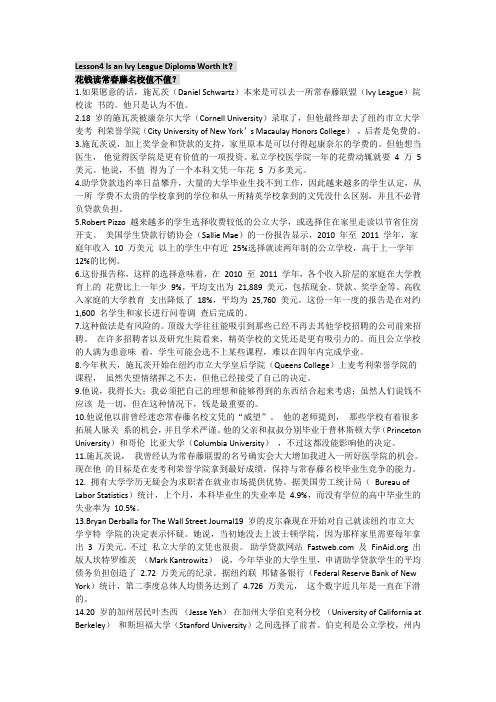
Lesson4 Is an Ivy League Diploma Worth It?花钱读常春藤名校值不值?1.如果愿意的话,施瓦茨(Daniel Schwartz)本来是可以去一所常春藤联盟(Ivy League)院校读书的。
他只是认为不值。
2.18 岁的施瓦茨被康奈尔大学(Cornell University)录取了,但他最终却去了纽约市立大学麦考利荣誉学院(City University of New York’s Macaulay Honors College),后者是免费的。
3.施瓦茨说,加上奖学金和贷款的支持,家里原本是可以付得起康奈尔的学费的。
但他想当医生,他觉得医学院是更有价值的一项投资。
私立学校医学院一年的花费动辄就要4 万5 美元。
他说,不值得为了一个本科文凭一年花5 万多美元。
4.助学贷款违约率日益攀升,大量的大学毕业生找不到工作,因此越来越多的学生认定,从一所学费不太贵的学校拿到的学位和从一所精英学校拿到的文凭没什么区别,并且不必背负贷款负担。
5.Robert Pizzo 越来越多的学生选择收费较低的公立大学,或选择住在家里走读以节省住房开支。
美国学生贷款行销协会(Sallie Mae)的一份报告显示,2010 年至2011 学年,家庭年收入10 万美元以上的学生中有近25%选择就读两年制的公立学校,高于上一学年12%的比例。
6.这份报告称,这样的选择意味着,在2010 至2011 学年,各个收入阶层的家庭在大学教育上的花费比上一年少9%,平均支出为21,889 美元,包括现金、贷款、奖学金等。
高收入家庭的大学教育支出降低了18%,平均为25,760 美元。
这份一年一度的报告是在对约1,600 名学生和家长进行问卷调查后完成的。
7.这种做法是有风险的。
顶级大学往往能吸引到那些已经不再去其他学校招聘的公司前来招聘。
在许多招聘者以及研究生院看来,精英学校的文凭还是更有吸引力的。
美英报刊阅读教程Lesson 3 课文
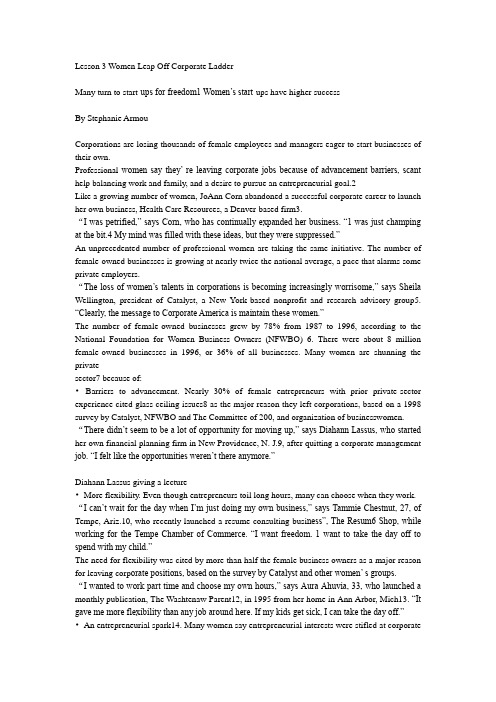
Lesson 3 Women Leap Off Corporate LadderMany turn to start-ups for freedom1 Women’s start-ups have higher successBy Stephanie ArmouCorporations are losing thousands of female employees and managers eager to start businesses of their own.Professional women say they’ re leaving corporate jobs because of advancement barriers, scant help balancing work and family, and a desire to pursue an entrepreneurial goal.2Like a growing number of women, JoAnn Corn abandoned a successful corporate career to launch her own business, Health Care Resources, a Denver-based firm3.“I was petrified,” says Corn, who has continually expanded her business. “1 was just champing at the bit.4 My mind was filled with these ideas, but they were suppressed.”An unprecedented number of professional women are taking the same initiative. The number of female-owned businesses is growing at nearly twice the national average, a pace that alarms some private employers.“The loss of women’s talents in corporations is becoming increasingly worrisome,” says Sheila Wellington, president of Catalyst, a New York-based nonprofit and research advisory group5. “Clearly, the message to Corporate America is maintain these women.”The number of female-owned businesses grew by 78% from 1987 to 1996, according to the National Foundation for Women Business Owners (NFWBO) 6. There were about 8 million female-owned businesses in 1996, or 36% of all businesses. Many women are shunning the privatesector7 because of:•Barriers to advancement. Nearly 30% of female entrepreneurs with prior private-sector experience cited glass-ceiling issues8 as the major reason they left corporations, based on a 1998 survey by Catalyst, NFWBO and The Committee of 200, and organization of businesswomen. “There didn’t seem to be a lot of opportunity for moving up,” says Diahann Lassus, who started her own financial planning firm in New Providence, N. J.9, after quitting a corporate management job. “I felt like the opportunities weren’t there anymore.”Diahann Lassus giving a lecture•More flexibility. Even though entrepreneurs toil long hours, many can choose when they work. “I can’t wait for the day when I’m just doing my own business,” says Tammie Chestnut, 27, of Tempe, Ariz.10, who recently launched a resume consulting busi ness”, The Resum6 Shop, while working for the Tempe Chamber of Commerce. “I want freedom. 1 want to take the day off to spend with my child.”The need for flexibility was cited by more than half the female business owners as a major reason for leaving corp orate positions, based on the survey by Catalyst and other women’ s groups.“I wanted to work part time and choose my own hours,” says Aura Ahuvia, 33, who launched a monthly publication, The Washtenaw Parent12, in 1995 from her home in Ann Arbor, Mich13. “It gave me more flexibility than any job around here. If my kids get sick, I can take the day off.”•An entrepreneurial spark14. Many women say entrepreneurial interests were stifled at corporatejobs.“As you get larger, it’s really a struggle to think outside the box15,” says Lois Haber, CEO of Delaware V alley Financial Services in Berwyn, Pa.16, which uses a focus group to foster creativity. “You just want to get the work done.”Female-owned firms generate about $2.3 trillion in revenue, a 236% jump from 1987 to 1996. Female business owners employ about 18.5 million people, which means one out of every four company workers in the USA is at a female-owned firm. “The rise in women entrepreneurs is one of the big demographics changing our society,” says Ly nn Neeley, president-elect of the United States Association for Small Business and Entrepreneurship.Female entrepreneursAnd it’s an issue causing mounting concern for private employers trying to hold onto top hires17. Deloitte & Touche, for example, started programs such as flexible work arrangements to help stanch turnover. Others are taking advantage of the disillusionment: McDonald’s ads woo franchisees with the slogan “Golden Arches, not glass ceilings.”18“Women starting businesses today compared to 20 years ago are more likely to leave because they’re frustrated,” says Julie Weeks, research director at NFWBO. “Those are the kind of employees companies would love to keep.”But going solo is no guarantee of success.19 Women report they struggle to be taken seriously. Hours can be grueling. Failure rates are high.While start-ups often have a shaky future, there is promise. Female-owned businesses are more likely to remain in operation than the average firm. The fastest growth today among female-owned firms includes manufacturing, construction, whole-sale distribution and agribusiness.“They see an opportunity to make a difference and become involved,” says Sharon Hadary, executive director of NFWBO. “Not only do we have more women-owned business, the businesses we have are more sophisticated and larger. The businesses themselves are becoming more substantial.”The Small Business Administration reports that nearly three-fourths of female-owned firms launched in 1991 were still operating three years later, vs. two-thirds of all companies.“The biggest obstacle is they’re not taken seriously,” says Phyllis Hill Slater, president of the National Association of Women Business Owners. “I tell women, ‘The more money you earn the more seriously you’ 11 be taken.’ ”Worth the riskMany women feel it’ s worth the gamble. Just last month, Geraldine Laybourne, the president of Walt Disney’ s20 cable networks, said she will leave to start a firm producing shows for women and children.Studies show women take greater risks. According to a survey, 59% of male business owners polled are in a business closely related to previous careers, while 56% of the women own businesses either totally unrelated to previous careers or that had been a personal interest.The shifts can be dramatic. Gail Johnson quit a job as a systems programmer to start Lasting Impression, which helps clients with presentation skills and business etiquette.21“This was always my love,” says Johnson, 50, of Lafayette, Calif.22 “It seemed appealing to be in charge and in control. You’ re out on a limb23 more and you have to wear many hats24, but I love it.”And today’s female entrepreneurs are more apt to be former managers and executives, reflectingwomen’ s advancement over the years.“I kept thinking, ‘Why am I making all this money for someone else?’” says Nina McLemore, who in 1995 co-founded Regent Capital Partners—an equity and debt investment firm—after being president of Liz Claibourne Accessories25.Business experts say companies will continue losing professional women if they don’t do more to encourage them to stay. They suggest retention and mentoring programs, flexible scheduling and a willingness to encourage creativity.Some women say nothing would entice them back. Sharon Fein, 41, started her travel agency instead of taking a management job with a large travel firm.“They wanted me to work more and longer hours for less pay. That’s management,” says Fein of Walnut Creek, Calif.26 “That wasn’ t going to do it. I felt like I didn’ t have a choice.It’ s not without challenges, but it’ s gone very well.”From USA Today, June 9, 1998V. Analysis of Content1. According to this article, private employers __________A. are indifferent to the leaving of top female employeesB. are trying to hold onto female employeesC. have done nothing to attract the femalesD. can easily find male employees to replace female hires2. According to this article, which of the following statements is wrong ?A. Today, female-owned firms are more likely to remain in operation than the average firm.B. The failure rate of female-owned firms is lower than that of the average firm.C. In comparison to men, women take fewer risks in starting a business.D. More than half of female owners are in a business irrelevant to previous careers.3. The sentence “… you have to wear many hats, …” in the last paragraph means ___________.A. you have to put many hats on your headB. you have to take up many responsibilitiesC. you have to take many risksD. you will feel cold at a high position4. The central idea of this article is that__________.A. private employees should do more to encourage their female employees to stayB. women are more independent in the business worldC. female-owned companies are more robust than the average firmD. it ‘ s a growing trend for women to leave corporate jobs to start their own businesses VI. Questions on the Article1. According to this article, what causes professional women to leave their corporate jobs?2. What was the major reason for 30 percent of women’ s decision to leave corporations?3. What does “More flexibility” in this article refer to?4. According to the article, is it easy for women to run their own business?Topics for Discussion1, Do you think it is a good phenomenon that women start their own businesses?2. Do you think that women in the United States enjoy equal treatment as men?。
课文翻译英美报刊阅读教程中级精选本第五版端木义万Lesson18
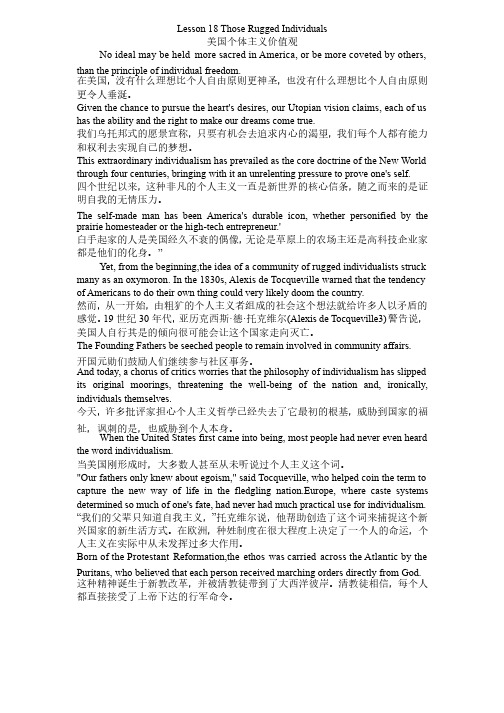
Lesson 18 Those Rugged Individuals美国个体主义价值观美国个体主义价值观No ideal may be held more sacred in America, or be more coveted by others, than the principle of individual freedom. 在美国,没有什么理想比个人自由原则更神圣,也没有什么理想比个人自由原则更令人垂涎。
更令人垂涎。
Given the chance to pursue the heart's desires, our Utopian vision claims, each of us has the ability and the right to make our dreams come true.我们乌托邦式的愿景宣称,只要有机会去追求内心的渴望,我们每个人都有能力和权利去实现自己的梦想。
和权利去实现自己的梦想。
This extraordinary individualism has prevailed as the core doctrine of the New World through four centuries, bringing with it an unrelenting pressure to prove one's self. 四个世纪以来,这种非凡的个人主义一直是新世界的核心信条,随之而来的是证明自我的无情压力。
明自我的无情压力。
The self self--made man has been America's durable icon, whether personified by the prairie homesteader or the high prairie homesteader or the high--tech entrepreneur.'白手起家的人是美国经久不衰的偶像,无论是草原上的农场主还是高科技企业家都是他们的化身。
英美报刊阅读教程文章 feeling at home summarise

There are smaller groups of immigrants` children do far better than others.A recent study indicate the cause for this phenomenon is their parental background.In addition,an immigrant children also had some handicaps,they couldn`t ask for help from their parents.Not surprisingly,then,the children of the educated and skilled rise more easily than the children of the rural unskilled,and the second group has problems in the job market for some raeson.
美英报刊文章选读 译文

《美英报刊文章阅读》China Finds Western ways bring new woes中国对于美国而言,是增长最快的市场,是反恐战争中的盟友,同时也是在亚洲地区最大的竞争者。
在即将到来的这一年里,这个国家的主要城市将会承办奥运会和世博会,同时,它的电影明星,时尚人士以及体育明星在海外拥有着越来越多的支持者。
似乎中国在21世纪将会开始重现其在1840年以前持续了数千年的辉煌。
但是,中国的领导人们依然面临很多棘手的问题。
粗暴对待不同政见者的专断行政系统需要改革。
在所有发展中国家都存在的经济发展不平衡问题。
环境退化问题,贫穷问题以及疾病预防问题等等。
考虑到这个世界上人口最多的国家是如此重要,USA TODAY将会对于‘中国的世纪’这个说法进行持续一年的抽样调查,看看有多少是已经做到的,有多少还没有完成。
北京—整个中国在25年改革开放政策带来的好日子的标志。
高楼大厦呈现出现代都市的景象。
道路上密集的私家轿车取代了自行车。
流行品牌广告栏下生气勃勃衣着入时的男女。
自从中国领导人在1978年开始实施自由经济之后,现在的中国已经不再是一个贫穷而封闭的国家。
但是这些令人瞩目的发展掩盖了那些伴随资本主义的增长而来的隐患。
对群众的调查是检验发生在中国的翻天覆地的变化的最好的方法。
看看现在的中国人的食物,再想想那场发生在20世纪60年代早期的那次灾难——上百万人因饥荒而死去。
而现在,超过五分之一的成年人体重超标,这一比例在20年间增长了将近40%。
与消耗食品数量同时增长的是酒类,较之1978,平均每个中国人的饮酒数量已经翻了4倍。
尽管酒精中毒的比例仍然低于西方标准,但是在城市地区,这已经是个很严重的问题了。
富裕生活的不良影响逐步显现中国正在努力朝小康生活奋斗,很多中国人放弃了传统的生活方式转为西式的放纵生活。
公共卫生的调查结果显示这些人的健康问题非常严重。
根据北卡大学研究发展中国家饮食的经济学家Barry Popkin的研究结果,1995年到2025年,因不健康饮食导致的心脏病,高血压,心肌梗塞,糖尿病而死亡的人数将会增加10倍,超过了人口的增长速度。
美英报刊阅读教程Lesson 6 课文
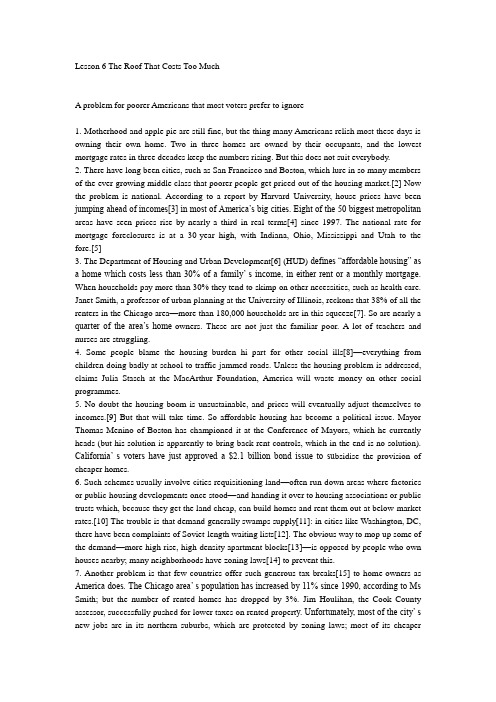
Lesson 6 The Roof That Costs Too MuchA problem for poorer Americans that most voters prefer to ignore1. Motherhood and apple pie are still fine, but the thing many Americans relish most these days is owning their own home. Two in three homes are owned by their occupants, and the lowest mortgage rates in three decades keep the numbers rising. But this does not suit everybody.2. There have long been cities, such as San Francisco and Boston, which lure in so many members of the ever-growing middle class that poorer people get priced out of the housing market.[2] Now the problem is national. According to a report by Harvard University, house prices have been jumping ahead of incomes[3] in most of America’s big cities. Eight of the 50 biggest metropolitan areas have seen prices rise by nearly a third in real terms[4] since 1997. The national rate for mortgage foreclosures is at a 30-year high, with Indiana, Ohio, Mississippi and Utah to the fore.[5]3. The Department of Housing and Urban Development[6] (HUD) defines “affordable housing” asa home which costs less than 30% of a family’ s income, in either rent or a monthly mortgage. When households pay more than 30% they tend to skimp on other necessities, such as health care. Janet Smith, a professor of urban planning at the University of Illinois, reckons that 38% of all the renters in the Chicago area—more than 180,000 households are in this squeeze[7]. So are nearly a quarter of the area’s home-owners. These are not just the familiar poor. A lot of teachers and nurses are struggling.4. Some people blame the housing burden hi part for other social ills[8]—everything from children doing badly at school to traffic-jammed roads. Unless the housing problem is addressed, claims Julia Stasch at the MacArthur Foundation, America will waste money on other social programmes.5. No doubt the housing boom is unsustainable, and prices will eventually adjust themselves to incomes.[9] But that will take time. So affordable housing has become a political issue. Mayor Thomas Menino of Boston has championed it at the Conference of Mayors, which he currently heads (but his solution is apparently to bring back rent controls, which in the end is no solution). California’ s voters have just approved a $2.1 billion bond issue to su bsidise the provision of cheaper homes.6. Such schemes usually involve cities requisitioning land—often run-down areas where factories or public-housing developments once stood—and handing it over to housing associations or public trusts which, because they get the land cheap, can build homes and rent them out at below-market rates.[10] The trouble is that demand generally swamps supply[11]: in cities like Washington, DC, there have been complaints of Soviet-length waiting lists[12]. The obvious way to mop up some of the demand—more high-rise, high-density apartment blocks[13]—is opposed by people who own houses nearby; many neighborhoods have zoning laws[14] to prevent this.7. Another problem is that few countries offer such generous tax breaks[15] to home-owners as America does. The Chicago area’ s population has increased by 11% since 1990, according to Ms Smith; but the number of rented homes has dropped by 3%. Jim Houlihan, the Cook County assessor, successfully pushed for lower taxes on rented propert y. Unfortunately, most of the city’ s new jobs are in its northern suburbs, which are protected by zoning laws; most of its cheaperhousing is in the south. If people live a long way from their work, business suffers, the transport system creaks, and the environment (think of those car fumes) takes a beating.[16]8. An organization called Metropolis 2020 estimates that the Chicago area will need another 352,000 homes by 2020. But many neighborhoods are suspicious of anything labelled “affordable housing”, o ften assuming that it means public housing (which they rightly or wrongly [17] associate with racial minorities, drugs, gangs and violence). It is true that cheap housing projects do tend to be built in poorer areas. One of the biggest in the country is a $1.6 billion scheme in Chicago: the city is knocking down some of its nastiest public-housing projects, including the notorious Cabrini Green. But the 25,000 new units it is building in their place are divided between public housing, subsidized homes and market-rate ones[18].9. Some people argue that the federal government should step in—by creating a National Housing Trust Fund[19] to help build cheaper homes; by altering the tax system; by making the Federal Housing Association[20] more efficient. But HU D’ s boss, Mel Martinez, has told the mayors that “the solution will not come out of Washington”. He wants the private sector and non-profit organizations to take the lead.10. In the end, it may be true that the only answer is to allow the building, or renovation, of a lot more cheap housing. But many middle-class voters do not want that in their communities. “Mosl Americans don’t think there’s a housing problem,” says Nicolas Retsinas of Harvard. Mosl homeowners are still happy with rising prices. Affluent baby-boomers[21] will probably ignore the problem until their children decide that it is cheaper to stay with mum and dad than pay a fortune foi their own homes. And by then the property market will doubtless have crashed.[22] From The Economist, December 7,20021. roof: ⊙ three generations living under one roof. 住在一个屋顶下的三代人the roof of a car. 车顶A roof on prices is needed to keep our customers happy. 最好使最高物价能让我们的顾客满意the roof of the world 世界屋脊; 高的山脉 the roof of heaven 天空 the roof of the mouth 上颚under sb.'s roof 住在某人家作客; 寄人篱下; 在某人的照应下When I told her about breaking the window, she went through the roof. 她听我说有关砸碎窗户的事时大发雷霆Angry tenants finally raised the roof about their noisy neighbors. 愤怒的房客终于对吵闹喧哗的邻居提出强烈抗议2. motherhood: n. 母性, 为母之道, 母亲身份, 母亲们(集合称), 母爱3. relish: n. An appetite for something; a strong appreciation or liking: 胃口:对某事物的食欲,强烈的欣赏或者喜欢:独特的滋味⊙ a relish for luxury. 对奢侈品的爱好, have no relish for tragedy 不喜欢看悲剧 eat [read]with relish 津津有味地吃[读] lose [lack] relish 失去[没有]吸引力Hunger gives relish to any food. 肚子饿时吃什么都香。
美英报刊阅读教程Lesson16课文
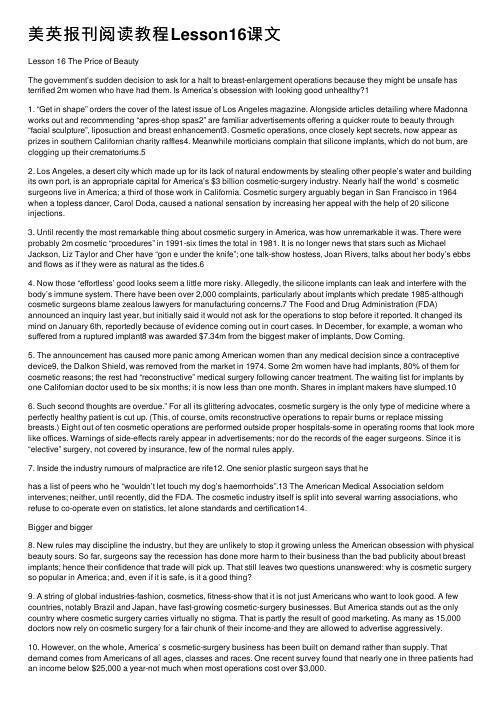
美英报刊阅读教程Lesson16课⽂Lesson 16 The Price of BeautyThe government’s sudden decision to ask for a halt to breast-enlargement operations because they might be unsafe has terrified 2m women who have had them. Is America’s obsession with looking good unhealthy?11. “Get in shape” orders the cover of the latest issue of Los Angeles magazine. Alongside articles detailing where Madonna works out and recommending “apres-shop spas2” are familiar advertisements offering a quicker route to beauty through “facial sculpture”, liposuction and breast enhancement3. Cosmetic operations, once closely kept secrets, now appear as prizes in southern Californian charity raffles4. Meanwhile morticians complain that silicone implants, which do not burn, are clogging up their crematoriums.52. Los Angeles, a desert city which made up for its lack of natural endowments by stealing other people’s water and building its own port, is an appropriate capital for America’s $3 billion cosmetic-surgery industry. Nearly half the world’ s cosmetic surgeons live in America; a third of those work in California. Cosmetic surgery arguably began in San Francisco in 1964 when a topless dancer, Carol Doda, caused a national sensation by increasing her appeal with the help of 20 silicone injections.3. Until recently the most remarkable thing about cosmetic surgery in America, was how unremarkable it was. There were probably 2m cosmetic “procedures” in 1991-six times the total in 1981. It is no longer news that stars such as Michael Jackson, Liz Taylor and Cher have “gon e under the knife”; one talk-show hostess, Joan Rivers, talks about her body’s ebbs and flows as if they were as natural as the tides.64. Now those “effortless’ good looks seem a little more risky. Allegedly, the silicone implants can leak and interfere with the body’s immune system. There have been over 2,000 complaints, particularly about implants which predate 1985-although cosmetic surgeons blame zealous lawyers for manufacturing concerns.7 The Food and Drug Administration (FDA) announced an inquiry last year, but initially said it would not ask for the operations to stop before it reported. It changed its mind on January 6th, reportedly because of evidence coming out in court cases. In December, for example, a woman who suffered from a ruptured implant8 was awarded $7.34m from the biggest maker of implants, Dow Corning.5. The announcement has caused more panic among American women than any medical decision since a contraceptive device9, the Dalkon Shield, was removed from the market in 1974. Some 2m women have had implants, 80% of them for cosmetic reasons; the rest had “reconstructive” medical surgery following cancer treatment. The waiting list for implants by one Californian doctor used to be six months; it is now less than one month. Shares in implant makers have slumped.106. Such second thoughts are overdue.” For all its glittering advocates, cosmetic surgery is the only type of medicine where a perfectly healthy patient is cut up. (This, of course, omits reconstructive operations to repair burns or replace missing breasts.) Eight out of ten cosmetic operations are performed outside proper hospitals-some in operating rooms that look more like offices. Warnings of side-effects rarely appear in advertisements; nor do the records of the eager surgeons. Since it is “elective” surgery, not covered by insurance, few of the normal rules apply.7. Inside the industry rumours of malpractice are rife12. One senior plastic surgeon says that hehas a list of peers who he “wouldn’t let touch my dog’s haemorrhoids”.13 The American Medical Association seldom intervenes; neither, until recently, did the FDA. The cosmetic industry itself is split into several warring associations, who refuse to co-operate even on statistics, let alone standards and certification14.Bigger and bigger8. New rules may discipline the industry, but they are unlikely to stop it growing unless the American obsession with physical beauty sours. So far, surgeons say the recession has done more harm to their business than the bad publicity about breast implants; hence their confidence that trade will pick up. That still leaves two questions unanswered: why is cosmetic surgery so popular in America; and, even if it is safe, is it a good thing?9. A string of global industries-fashion, cosmetics, fitness-show that it is not just Americans who want to look good. A few countries, notably Brazil and Japan, have fast-growing cosmetic-surgery businesses. But America stands out as the only country where cosmetic surgery carries virtually no stigma. That is partly the result of good marketing. As many as 15,000 doctors now rely on cosmetic surgery for a fair chunk of their income-and they are allowed to advertise aggressively.10. However, on the whole, America’ s cosmetic-surgery business has been built on demand rather than supply. That demand comes from Americans of all ages, classes and races. One recent survey found that nearly one in three patients had an income below $25,000 a year-not much when most operations cost over $3,000.11. According to the American Academy of Cosmetic Surgery, breast enlargement, which costs between $2,000 and $4,000, was only the tenth most popular cosmetic procedure in 1990. Topping the wish list was sclerotherapy (the removal of spider veins15 in the legs), followed by collagen injections to get rid of facial lines, then nose-jobs, lip-jobs and liposuction (fat removal). But among clients of the rival American Society of Plastic and Reconstructive Surgeons, breast enlargement, collagen injections and eyelid surgery were roughly equal as the three most popular operations.12. When pushed to defend their trade, cosmetic surgeons argue that “vanity surgery” is often just an extension of reconstructive surgery. For example, redesigning the nose of a young boy, perpetually :eased because of his prominent conk16, can turn a problem teenager into a well-adjusted man. Cosmetic survey follows two great American traditions: a refusal to surrender to an environment and a willingness to give people a second chance. What is the difference, some ask, between removing excess fat in an hour on the operating table and three months in the gym? “I don’t intend to grow old gracefully,17” says a woman in a television advertisement for an ambitious skin cream, “I intend to fight it every step of the way.”13. Many, however, admit that there is a darker side. Psychologists point out that many operations are not to get rid of deformity18, but to make perfectly good looks even better. The Los Angeles Times recently reported that the beginning of the swimsuit season prompts a rush of breast implants; school reunions are good for the face-lift business.Growing old gracelessly14. Such competitive narcissism19 stretches into employment too. Larry Schoenrock of the University of California at San Francisco points out that good-looking people are more likely to get jobs. Most are women aiming to please prospective male bosses; but many male patients citetheir careers as the chief reason for going under the scalpel20.15. For ethnic minorities, the most popular operations are ones that change their racial characteristics. Asians want wider eyes; blacks want thinner lips. Critics say this is surrendering their identities to the white stereotypes that appear on the media. Surgeons say the point is more subtle: minorities want to de-emphasise rather than eradicate their looks21. For example, one Californian surgeon says that many blacks specifically ask that, after their operations, they should not look like Michael Jackson, who now has a “white” nose and “white” skin.16. Some trend-spotters22 detect the beginnings of a reaction against the knife. Non-surgical methods to reduce wrinkles, such as electronic massage machines, are selling fast. Last year the number of face-lifts completed increased by less than 1%. Cosmetic surgery can only hold back age; it cannot defeat it.23 Mr. Jackson, who has been described as the PeterPan24 of the music industry, might reflect on Maurice Chevalier’s sanguine attitude25 to the appearance of a few wrinkles. “I prefer old age to the alternative,” he said.From The Economist, January llth, 1992。
美英报刊阅读教程Lesson 1 课文
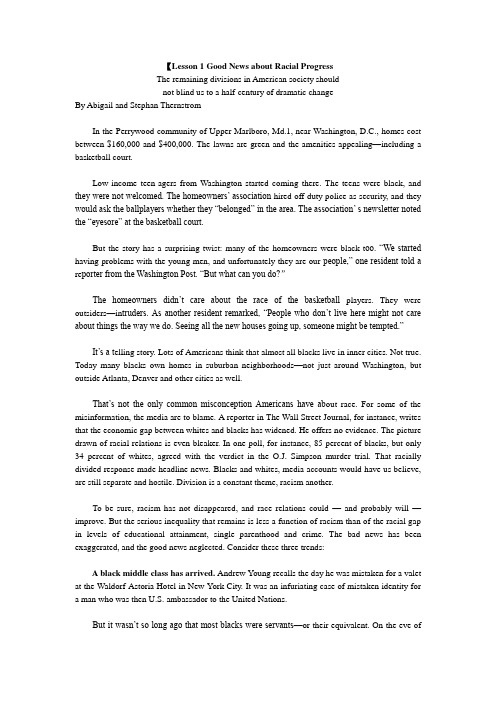
【Lesson 1 Good News about Racial ProgressThe remaining divisions in American society shouldnot blind us to a half-century of dramatic changeBy Abigail and Stephan ThernstromIn the Perrywood community of Upper Marlboro, Md.1, near Washington, D.C., homes cost between $160,000 and $400,000. The lawns are green and the amenities appealing—including a basketball court.Low-income teen-agers from Washington started coming there. The teens were black, and they were not welcomed. The homeowners’ association hired off-duty police as security, and they would ask the ballplayers whether they “belonged” in the area. The association’ s newsletter noted the “eyesore” at the basketball court.But the story has a surprising twist: many of the homeowners were black t oo. “We started having problems with the young men, and unfortunately they are our people,” one resident told a re porter from the Washington Post. “But what can you do?”The homeowners didn’t care about the race of the basketball players. They were outsiders—in truders. As another resident remarked, “People who don’t live here might not care about things the way we do. Seeing all the new houses going up, someone might be tempted.”It’s a t elling story. Lots of Americans think that almost all blacks live in inner cities. Not true. Today many blacks own homes in suburban neighborhoods—not just around Washington, but outside Atlanta, Denver and other cities as well.That’s not the only common misconception Americans have ab out race. For some of the misinformation, the media are to blame. A reporter in The Wall Street Journal, for instance, writes that the economic gap between whites and blacks has widened. He offers no evidence. The picture drawn of racial relations is even bleaker. In one poll, for instance, 85 percent of blacks, but only 34 percent of whites, agreed with the verdict in the O.J. Simpson murder trial. That racially divided response made headline news. Blacks and whites, media accounts would have us believe, are still separate and hostile. Division is a constant theme, racism another.To be sure, racism has not disappeared, and race relations could —and probably will —improve. But the serious inequality that remains is less a function of racism than of the racial gap in levels of educational attainment, single parenthood and crime. The bad news has been exaggerated, and the good news neglected. Consider these three trends:A black middle class has arrived. Andrew Young recalls the day he was mistaken for a valet at the Waldorf-Astoria Hotel in New York City. It was an infuriating case of mistaken identity for a man who was then U.S. ambassador to the United Nations.But it wasn’t so long ago that most blacks were servants—or their equivalent. On the eve ofWorld War II, a trivial five percent of black men were engaged in white-collar work of any kind, and six out of ten African-American women were employed as domestics.In 1940 there were only 1,000 practicing African-American lawyers; by 1995 there were over 32,000, about four percent of all attorneys.Today almost three-quarters of African-American families have incomes above the government poverty line. Many are in the middle class, according to one useful index—earning double the government poverty level; in 1995 this was $30,910 for a two-parent family with two children and $40,728 for a two-parent family with four children. Only one black family in 100 enjoyed a middle-class income in 1940; by 1995 it was 49 in 100. And more than 40 percent of black households also own their homes. That’ s a huge change.The typical white family still earns a lot more than the black family because it is more likely to collect two paychecks. But if we look only at married couples—much of the middle class—the white-black income gap shrinks to 13 percent. Much of that gap can be explained by the smaller percentage of blacks with college degrees, which boost wages, and the greater concentration of blacks in the South, where wages tend to be lower.Blacks are moving to the suburbs. Following the urban riots of the mid-1960s, the presidential Kerner Commission14 concluded that the nation’ s future was menaced by “accelerating segregation”—black central cities and whites outside the core. That segregation might well blow the country apart, it said.It’ s true that whites have continued to leave inner cities for the suburbs, but so, too, have blacks. The number of black suburban dwellers in the last generation has almost tripled to 10.6 million. In 1970 metropolitan Atlanta, for example, 27 percent of blacks lived in the suburbs with 85 percent of whites. By 1990, 64 percent of blacks and 94 percent of whites resided there.This is not phony integration, with blacks moving from one all-black neighborhood into another. Most of the movement has brought African-Americans into neighborhoods much less black15 than those they left behind, thus increasing integration. By 1994 six in ten whites reported that they lived in neighborhoods with blacks.Residential patterns do remain closely connected to race. However, neighborhoods have become more racially mixed, and residential segregation has been decreasing.Bigotry has declined. Before World Was ft, Gunnar Myrdal16 roamed the South researching An American Dilemma, the now-classic book that documented17 the chasm betwe en the nation’s ideals and its racial practices, hi one small Southern city, he kept asking whites how he could find “Mr. Jim Smith,” an African-American who was principal of a black high school. No one seemed to know who he was. After he finally found Smith, Myrdal was told that he should have just asked for “Jim.” That’ s how great was white aversion to dignifying African-Americans with “Mr.” Or “Mrs.”Bigotry was not just a Southern problem. A national survey in the 1940s asked whether “Ne-groes shoul d have as good a chance as white people to get any kind of job.” A majority of whites said that “white people should have the first chance at any kind of job.”19. Such a question would not even be asked today. Except for a lunatic fringe18, no whites would sign on to such a notion.1920. In 1964 less than one in five whites reported having a black friend. By 1989 more than two out of three did. And more than eight often African -Americans had a white friend.21. What about the last taboo?20 In 1963 ten percent of whites approved of black-white dating; by 1994 it was 65 percent. Interracial marriages? Four percent of whites said it was okay in 1958; by 1994 the figure had climbed more than elevenfold, to 45 percent. These surveys measure opinion, but behavior has also changed. In 1963 less than one percent of marriages by African- Americans were racially mixed. By 1993, 12 percent were.22. Today black Americans can climb the ladder to the top.21 Ann M. Fudge is already there; she’s in charge of manufacturing, promotion and sales at the $2.7-billion Maxwell House Coffee and Post Cereals divisions of Kraft Foods.22 So are Kenneth Chenault, president and chief operating officer at American Express23 and Richard D. Parsons, president of Time Warner, Inc.24 After the 1988 Demo-cratic Convention25, the Rev. Jesse Jackson26 talked about his chances of making it to the White House. “I may not get there,” he said “But it is possible for our children to get there now.”23. Even that seems too pessimistic. Consider how things have improved since Colin and Alma Powell27 packed their belongings into a V olkswagen28 and left Fort Devens, Mass., for Fort Bragg, N. C. “I remember passing Woodbridgc, Va.,” General Powell wrote in his autobiogra phy, “and not finding even a gas-station bathroom that we were allowed to use.” That was in 1962. In 1996 reliable polls suggest he could have been elected President.24. Progress over the last half-century has been dramatic. As Corctta Scott King wrote not long ago, the ideals for which her husband Martin Luther King Jr. died, have become “deeply embedded in the very fabric of America29.”From Reader’s Digest, March, 1998V. Analysis of Content1. According to the author, ___________A. racism has disappeared in AmericaB. little progress has been made in race relationsC. media reports have exaggerated the racial gapD. media accounts have made people believe that the gap between blacks and whites has become narrower2. What the Kerner Commi ssion meant by “accelerating segregation” was that __________A. more and more whites and blacks were forced to live and work separatelyB. more and more blacks lived in the central cities, and whites outside the coreC. more and more whites lived in the central cities, and blacks outside the coreD. nowadays more and more blacks begin to live in the suburbs3. The last taboo in the article is about ____________.A. political status of America’s minority peopleB. economic status of America’ s minori ty peopleC. racial integrationD. interracial marriages4. Gunnar Myrdal kept asking whites how he could find “Mr. Jim Smith,” but no one seemed to know who he was, because _____________.A. there was not such a person called Jim SmithB. Jim Smith was not famousC. the whites didn ‘t know Jim SmithD. the white people considered that a black man did not deserve the title of “Mr.”5. In the author’s opinion, _A. few black Americans can climb the ladder to the topB. Jesse Jackson’ s words in th is article seemed too pessimisticC. Colin Powell could never have been elected PresidentD. blacks can never become America’ s PresidentVI. Questions on the Article1. Why were those low-income teen-agers who came to the Perrywood community consid-ered to be “the eyesore”?2. What is the surprising twist of the story?3. According to this article, what has caused much of the white-black income gap?4. Why did the presidential Kerner Commission conclude that the nation’ s future was menaced by “accelerating segregation”?5. Why wouldn’t questions as “Should negroes have as good a chance as white people to get any kind of job?” be asked today?Topics for Discussion1. Can you tell briefly the dramatic progress in the status of America’ s minority p eople over the last half-century?2. Do you think the article is unbiased? What do you think of the author s view on the African-Americans?1. amenity: n. A. The quality of being pleasant or attractive; agreeableness. 怡人:使人愉快或吸引人的性质;使人愉快 B. A feature that increases attractiveness or value, especially of a piece of real estate or a geographic location.生活福利设施;便利设施:能够增加吸引力或价值的事物,特别是不动产或地理位置⊙ We enjoy all the -ties of home life. 我们享受家庭生活的一切乐趣。
课文翻译 英美报刊阅读教程中级精选本 第五版 端木义万 Lesson18
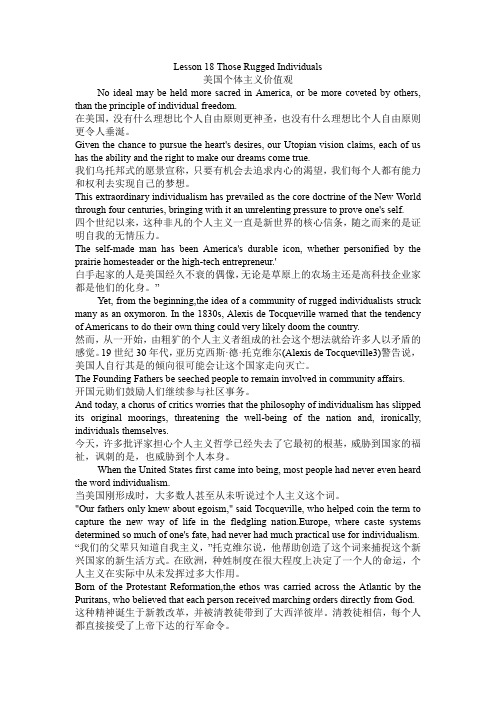
Lesson 18 Those Rugged Individuals美国个体主义价值观No ideal may be held more sacred in America, or be more coveted by others, than the principle of individual freedom.在美国,没有什么理想比个人自由原则更神圣,也没有什么理想比个人自由原则更令人垂涎。
Given the chance to pursue the heart's desires, our Utopian vision claims, each of us has the ability and the right to make our dreams come true.我们乌托邦式的愿景宣称,只要有机会去追求内心的渴望,我们每个人都有能力和权利去实现自己的梦想。
This extraordinary individualism has prevailed as the core doctrine of the New World through four centuries, bringing with it an unrelenting pressure to prove one's self.四个世纪以来,这种非凡的个人主义一直是新世界的核心信条,随之而来的是证明自我的无情压力。
The self-made man has been America's durable icon, whether personified by the prairie homesteader or the high-tech entrepreneur.'白手起家的人是美国经久不衰的偶像,无论是草原上的农场主还是高科技企业家都是他们的化身。
”Yet, from the beginning,the idea of a community of rugged individualists struck many as an oxymoron. In the 1830s, Alexis de Tocqueville warned that the tendency of Americans to do their own thing could very likely doom the country.然而,从一开始,由粗犷的个人主义者组成的社会这个想法就给许多人以矛盾的感觉。
课文翻译 英美报刊阅读教程中级精选本 第五版 端木义万 Lesson8
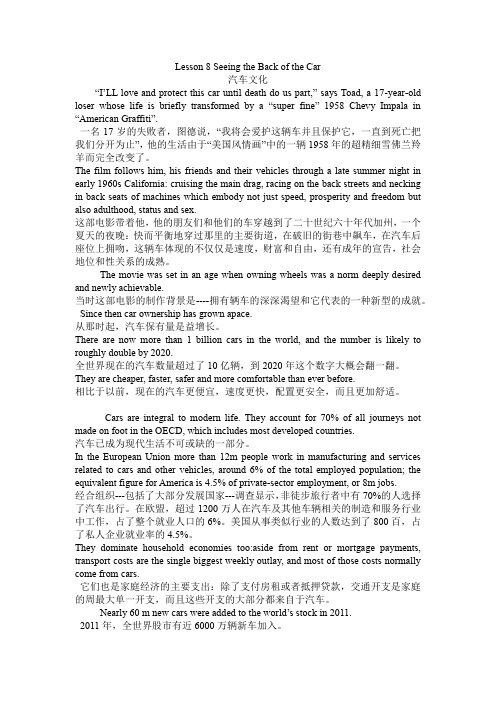
Lesson 8 Seeing the Back of the Car汽车文化“I’LL love and protect this car until death do us part,” says Toad, a 17-year-old loser whose life is briefly transformed by a “super fine” 1958 Chevy Impala in “American Graffiti”.一名17岁的失败者,图德说,“我将会爱护这辆车并且保护它,一直到死亡把我们分开为止”,他的生活由于“美国风情画”中的一辆1958年的超精细雪佛兰羚羊而完全改变了。
The film follows him, his friends and their vehicles through a late summer night in early 1960s California: cruising the main drag, racing on the back streets and necking in back seats of machines which embody not just speed, prosperity and freedom but also adulthood, status and sex.这部电影带着他,他的朋友们和他们的车穿越到了二十世纪六十年代加州,一个夏天的夜晚:快而平衡地穿过那里的主要街道,在破旧的街巷中飙车,在汽车后座位上拥吻,这辆车体现的不仅仅是速度,财富和自由,还有成年的宣告,社会地位和性关系的成熟。
The movie was set in an age when owning wheels was a norm deeply desired and newly achievable.当时这部电影的制作背景是----拥有辆车的深深渴望和它代表的一种新型的成就。
英美报刊课文翻译
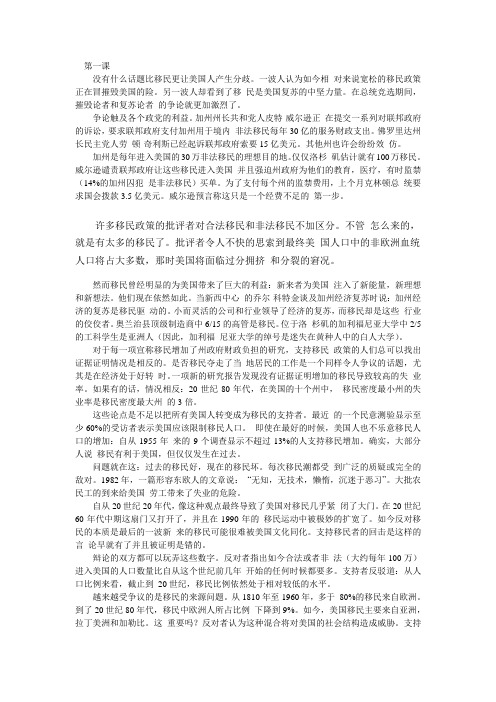
第一课没有什么话题比移民更让美国人产生分歧。
一波人认为如今相对来说宽松的移民政策正在冒摧毁美国的险。
另一波人却看到了移民是美国复苏的中坚力量。
在总统竞选期间,摧毁论者和复苏论者的争论就更加激烈了。
争论触及各个政党的利益。
加州州长共和党人皮特·威尔逊正在提交一系列对联邦政府的诉讼,要求联邦政府支付加州用于境内非法移民每年30亿的服务财政支出。
佛罗里达州长民主党人劳顿·奇利斯已经起诉联邦政府索要15亿美元。
其他州也许会纷纷效仿。
加州是每年进入美国的30万非法移民的理想目的地。
仅仅洛杉矶估计就有100万移民。
威尔逊谴责联邦政府让这些移民进入美国并且强迫州政府为他们的教育,医疗,有时监禁(14%的加州囚犯是非法移民)买单。
为了支付每个州的监禁费用,上个月克林顿总统要求国会拨款3.5亿美元。
威尔逊预言称这只是一个经费不足的第一步。
许多移民政策的批评者对合法移民和非法移民不加区分。
不管怎么来的,就是有太多的移民了。
批评者令人不快的思索到最终美国人口中的非欧洲血统人口将占大多数,那时美国将面临过分拥挤和分裂的窘况。
然而移民曾经明显的为美国带来了巨大的利益:新来者为美国注入了新能量,新理想和新想法。
他们现在依然如此。
当新西中心的乔尔·科特金谈及加州经济复苏时说:加州经济的复苏是移民驱动的。
小而灵活的公司和行业领导了经济的复苏,而移民却是这些行业的佼佼者。
奥兰治县顶级制造商中6/15的高管是移民。
位于洛杉矶的加利福尼亚大学中2/5的工科学生是亚洲人(因此,加利福尼亚大学的绰号是迷失在黄种人中的白人大学)。
对于每一项宣称移民增加了州政府财政负担的研究,支持移民政策的人们总可以找出证据证明情况是相反的。
是否移民夺走了当地居民的工作是一个同样令人争议的话题,尤其是在经济处于好转时。
一项新的研究报告发现没有证据证明增加的移民导致较高的失业率。
如果有的话,情况相反:20世纪80年代,在美国的十个州中,移民密度最小州的失业率是移民密度最大州的3倍。
英美报刊阅读第一课译文(第三版)

Home at last这是其中的一个通宵gabfests学生在毕业时,他们将友情,裸露最深的感觉。
只有这是更严重的:11同学聚集在公寓在哈佛商学院校园1999年5月,是中国的命运抗争。
包围着空啤酒瓶和包薯片,朋友们——所有来自中国大陆——正在讨论是否要回家了。
他们每个人都已经收到了来自美国顶尖的公司。
当然,中国发生了巨大变化的十年以来,他们中的大多数人都离开了。
政治和抗议仍是禁忌,但美国现在提供了更多的个人自由和经济的机会比以往任何时候都多。
和它急需精英经理喜欢他们。
张伟,一个活跃的29岁女性的梦想是成为中国的美国脱口秀主持人奥普拉·温芙瑞,恳求她的同学凭著他们回家。
“我们不会牺牲现在为了明天,”她说。
“我们应该马上做我们真正想做的事。
”这个词是纯粹的金钱,但他们证明预言。
在几周的时间里,也不愿在这房间里的最年轻的人——一个26岁的前国家数学冠军名叫哨Yibo——那里商业建议、出售他的财产留给了上海,他在那里举行中国版的网上拍卖巨人易趣。
在路上,他停下来休息一天在硅谷和说服投资者给他40万美元。
几周之后,同学镡海鹰回到上海拜访朋友开始之前一个银行的工作在纽约。
她从不使用她的回程机票到美国:邵说服她去参加他的公司的首席运营官。
三其他成员在一年之内的小团体——欢一茗,妮陈和赫伯特王建民——也回发射启动公司。
和张吗?她的工作是business-development降落在鲁珀特·默多克新闻集团在北京。
她也加班追求金钱的梦想。
一旦一个星期她主持一个受欢迎的电视脱口秀节目,在北京的主题是如此大胆艾滋病、药物滥用和——是的——网上约会。
长时间的中国学生聚集在HBS的,他们并不是寻找一个逃跑,但是他们最终的边缘。
经过多年的咨询公司,跨国公司或创业,所有的人都觉得需要更进一步的了解西方商业文化。
哈佛,中国学生迅速移聚在一起。
旧的手帮助新来的人学会开车,买菜,乘坐地铁。
三个人一起住在一所公寓里,因为他们煮中国菜,事情很快就成了。
美英报刊阅读教程课文翻译

第一篇它在1967年以美国139年获得100万人,而只有52年再增加1亿美元,返现,10月的一天,之后只有39的间隔年,美国将声称300多万灵魂。
瞬间将被喻为美国的无限活力和独特的生命力的又一象征。
它是这样的,当然。
不过,这也是事实美国已经成长人口普查局已经采取了测量,开始于1790年,当时创始人计数今天纽约市的人口不足4百万的同胞的,大约有一半的人口每天的时间。
最近的增长飙升已经不同凡响。
自2000年以来单,国家已经增加了20万人。
与西欧相比,出生率暴跌,还是日本,其人口萎缩,美国只知道增长,增长,更多的增长。
它现在拥有的第三大人口在世界上,中国和印度之后。
“经济增长是一个问题,我们必须要管理,说:”肯尼思·普鲁伊特,人口普查局前负责人,“但它更易于管理比失去你的人口。
”仔细检查号码,三大趋势出现。
首先是迁移。
由于工业基地东北部和中西部的下降,数以百万计的美国人已经转移到南部和西部,现在家里一半以上的人口和不断增长强劲。
移民是下一个。
在过去的四十年里,移民,主要来自墨西哥和拉丁美洲,已经重塑了国家的民族构成;的最新亿美国人,根据皮尤拉美裔中心的杰弗里·帕塞尔,53%要么是移民或他们的后代。
最后是大肆宣传的婴儿潮一代,现在许多人对退休的风口浪尖。
美国说,非营利性的人口资料局,“越来越大,年龄大了,更加多样化。
”的影响都是巨大而多样,影响美国的文化,政治,和经济性。
一个明显的例子就是对移民问题的辩论狂风暴雨涌动大会。
另:由于人口流动不断,国会选区重划会随之而来,引爆电力的地域平衡。
一个显着的年龄较大的美国也将对政府开支,所有这三个问题提供了新国会产生深远的影响,并太久,一个新总统之前,大量的思考。
THE NEW迁移博伊西,落基山山麓之间爱达荷州坐向东北和大盆地沙漠南,大天空和沙漠尘土飞扬之间,博伊西一直是先锋镇。
在19世纪初,传说,法裔加拿大毛皮捕手来到一个树丛,并惊呼“莱斯布瓦!”- 树林。
美英报刊阅读教程Lesson13课文
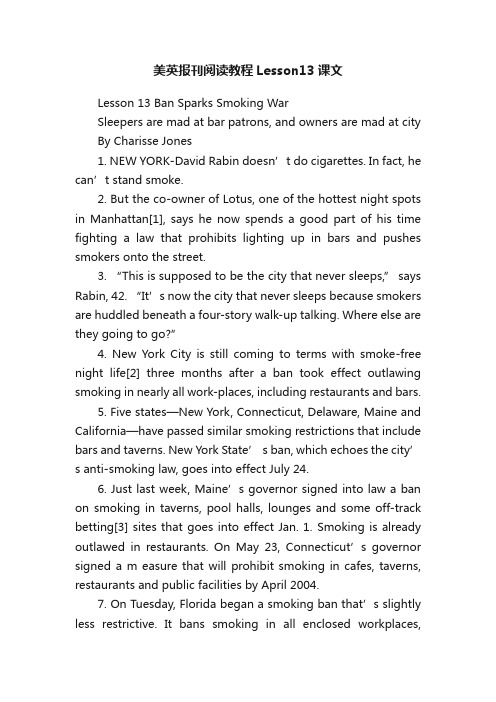
美英报刊阅读教程Lesson13课文Lesson 13 Ban Sparks Smoking WarSleepers are mad at bar patrons, and owners are mad at city By Charisse Jones1. NEW YORK-David Rabin doesn’t do cigarettes. In fact, he can’t stand smoke.2. But the co-owner of Lotus, one of the hottest night spots in Manhattan[1], says he now spends a good part of his time fighting a law that prohibits lighting up in bars and pushes smokers onto the street.3. “This is supposed to be the city that never sleeps,” says Rabin, 42. “It’s now the city that never sleeps because smokers are huddled beneath a four-story walk-up talking. Where else are they going to go?”4. New York City is still coming to terms with smoke-free night life[2] three months after a ban took effect outlawing smoking in nearly all work-places, including restaurants and bars.5. Five states—New York, Connecticut, Delaware, Maine and California—have passed similar smoking restrictions that include bars and taverns. Ne w York State’ s ban, which echoes the city’ s anti-smoking law, goes into effect July 24.6. Just last week, Maine’s governor signed into law a ban on smoking in taverns, pool halls, lounges and some off-track betting[3] sites that goes into effect Jan. 1. Smoking is already outlawed in restaurants. On May 23, Connecticut’s governor signed a m easure that will prohibit smoking in cafes, taverns, restaurants and public facilities by April 2004.7. On Tuesday, Florida began a smoking ban that’s slightly less restrictive. It bans smoking in all enclosed workplaces,including restaurants and bars where food sales make up at least 10% of their business.Business is off8. New York City’s law has sparked a million “butts” jokes in the tabloids and turned celebrities such as Britney Spears into alleged scofflaws for illegally puffing away.[4] And it has stirred fear and loathing among some residents and businesses that say customers don’t want to drink and nosh where they can’ t light up.9. One New York City councilman recently called on the city and state to consider amending the anti-smoking laws—a move other city officials say is unlikely. Owners and managers of cafes and bars from Queens[5] to Manhattan say that business is off as much as 40% and that they have been forced to lay off employees. Some community representatives say noise complaints have risen since pub denizens began lighting up on the sidewalk.10. “If what I’m hearing is correct, this is having a devastating effect on the city’s economic recovery,[6]” says Queens councilman Tony Avella, who says he reluctantly voted for the ban but thinks the council should revisit the issue[7].11. His office is receiving a dozen complaints a week about litter, noise and occasional rights among smokers outside nei ghborhood bars. “We need to find out if there’s a way to preserve public health and allow people to drink and smoke at the same time,” he says.12. Those who have studied the impact of anti-smoking measures say such laws protect the health of bartenders, waitresses and patrons and also bring in customers who were reluctant to socialize where smoking was allowed.[8]13. “What the data show is that no smoke-free air acts haveever hurt business,” says Tom Frieden, New York City’ s health commissioner. He says four out of five New Yorkers do not smoke.14. In a city of apartment dwellers, where people live above restaurants and pubs, some say long-standing tensions between businesses and residents have only risen since smokers were forced to congregate outside.15. “We have found that our number of complaints have increased regarding noise on the st reet, particularly when it conies to smokers,” says Kyle Merker, chairman of one of Manhattan’s community boards. “Realistically, are they going to repeal the law? N o. But maybe we can refine it.”Earlier closing time?16. Some club owners fear that anger about the excessive noise could make it harder for businesses to get liquor licenses, or it may lead to forcing businesses to close at 2 a.m. rather than 4, which Rabin fears would make New York no different than other cities.17. “This has brought about a civil war between night life and residents, both of whom have a legitimate right to exist,”[9] says Rabin, president of the New York Nightlife Association.18. Ciar an Staunton, owner of O’Neill’s in Manhattan, says business is off 20% as former patrons head home to Connecticut or New Jersey, where they can still smoke in a bar.19. I’ve met some of my patrons coming out of liquor stores with six-packs[10] saying, “We’re going to drink where we can smoke,” he says. “The original legislation was put in to he lp employees, to provide them with clean air…. Well, we’ve laid off three employees because of the smoking ban.”20. Others note that the sour economy could be one reason some bars and restaurants may be struggling.21. “These ordinances don’t have any eff ect on the hospitality business[11], and in the long term are very positive because they expand the market,” says Stanton Glantz of the University of California San Francisco, who has studied the economic impact of smoking bans.22. On the streets of the c ity, feelings about the smoking ban are mixed, but many say there’ s no more noise than before. And they appreciate the smoke-free air inside bars.23. “The noise is relatively low, and I only mind it when I’ m trying to go to sleep because of work in the morning,” says Tracy Wallach, 20, who lives next to The Coffee Shop bar and restaurant in Union Square.24. Even some bar managers have made their peace.[12]25. “The first few weeks, (fewer) people came in,” says Barry Brodsky, manager of Bar None in the East Village, “ Then they gave in.”From USA Today, June 3, 2003。
- 1、下载文档前请自行甄别文档内容的完整性,平台不提供额外的编辑、内容补充、找答案等附加服务。
- 2、"仅部分预览"的文档,不可在线预览部分如存在完整性等问题,可反馈申请退款(可完整预览的文档不适用该条件!)。
- 3、如文档侵犯您的权益,请联系客服反馈,我们会尽快为您处理(人工客服工作时间:9:00-18:30)。
美英报刊阅读教程课文翻译————————————————————————————————作者:————————————————————————————————日期:ﻩ第一篇它在1967年以美国139年获得100万人,而只有52年再增加1亿美元,返现,10月的一天,之后只有39的间隔年,美国将声称300多万灵魂。
瞬间将被喻为美国的无限活力和独特的生命力的又一象征。
它是这样的,当然。
不过,这也是事实美国已经成长人口普查局已经采取了测量,开始于1790年,当时创始人计数今天纽约市的人口不足4百万的同胞的,大约有一半的人口每天的时间。
最近的增长飙升已经不同凡响。
自2000年以来单,国家已经增加了20万人。
与西欧相比,出生率暴跌,还是日本,其人口萎缩,美国只知道增长,增长,更多的增长。
它现在拥有的第三大人口在世界上,中国和印度之后。
“经济增长是一个问题,我们必须要管理,说:”肯尼思·普鲁伊特,人口普查局前负责人,“但它更易于管理比失去你的人口。
”仔细检查号码,三大趋势出现。
首先是迁移。
由于工业基地东北部和中西部的下降,数以百万计的美国人已经转移到南部和西部,现在家里一半以上的人口和不断增长强劲。
移民是下一个。
在过去的四十年里,移民,主要来自墨西哥和拉丁美洲,已经重塑了国家的民族构成;的最新亿美国人,根据皮尤拉美裔中心的杰弗里·帕塞尔,53%要么是移民或他们的后代。
最后是大肆宣传的婴儿潮一代,现在许多人对退休的风口浪尖。
美国说,非营利性的人口资料局,“越来越大,年龄大了,更加多样化。
”的影响都是巨大而多样,影响美国的文化,政治,和经济性。
一个明显的例子就是对移民问题的辩论狂风暴雨涌动大会。
另:由于人口流动不断,国会选区重划会随之而来,引爆电力的地域平衡。
一个显着的年龄较大的美国也将对政府开支,所有这三个问题提供了新国会产生深远的影响,并太久,一个新总统之前,大量的思考。
THE NEW迁移博伊西,落基山山麓之间爱达荷州坐向东北和大盆地沙漠南,大天空和沙漠尘土飞扬之间,博伊西一直是先锋镇。
在19世纪初,传说,法裔加拿大毛皮捕手来到一个树丛,并惊呼“莱斯布瓦!”- 树林。
因此博伊西长大了采矿,伐木,农耕和枢纽,首都在美国最农业州之一。
那些悠闲的日子已经一去不复返了。
1970年的人口普查报告说,爱达荷州已成为农村比城市多;仅仅几年后,美光,是世界上最大的超导生产商,现在该州最大的私人雇主,在这里成立,和惠普的打印机工厂是在路上。
主业现在的增长和如何管理它。
博伊西都市区的人口增长只是1990年以来洋葱,甜菜农场紧靠细分甚至没有完成一半的79%;在Chinden大道,主要动脉,一个标志,宣布“干草出售”,从一个华丽的广告标语牌新派拉蒙住房开发跨站。
对于城市规划者面临的挑战是困难,因为它是赤裸裸的:找到足够的空间,住房和就业岗位增加一倍以上,或者甚至三博伊西的大都市区的人口,53万,因为它的收费走向2030年,当人口可能达到1.5万人。
“我们今天有什么,我们必须找到空间了。
......这是艰巨的,”詹姆斯说Grunke,在商会经济发展经理,正在寻找他的第八楼会议室的窗户朝脚下。
也许是艰巨的,但这样的毛白杨丰产林生长最市长的羡慕,虽然说实话不是所有Grunke的地区同行之间的少见。
四十年来,在东北部和中西部的代价,南部和西部已经脱去成为美国增长最快的地区,由移民提振,降低成本,和娱乐的机会。
从1990年到2000年,所有五个增长最快的国家正在走出西:内华达州(66%),亚利桑那州(40%),科罗拉多州(31%),犹他州(30%)和爱达荷州(29%)。
2004年至2005年,佛罗里达州,佐治亚州,北卡罗来纳州和德克萨斯州也跻身增长最快的州。
马萨诸塞州,相比之下,减少人口2000至2005年之间。
“这么便宜,”帕特里克斯威尼,自行车信使和酒保,谁离开旧金山两年前买的房子在博伊西的121000美元说。
“而且交通不是像加州东西。
这就是为什么我下了车。
”添加苏·威廉斯,49,谁曾经工作在AT&T,但离开华盛顿雷德蒙,为博伊西不到两个月前,是租房子与她10岁的儿子,她找一所房子:“我们希望买房子,你可以在微软的少于50万元买不到。
“超过80%的博伊西的居民认为休闲机会的城市顶级扳回一;12.5万人通过镇博伊西河中心去年浮动。
西雅图,波特兰,和加利福尼亚州最大的城市每年提供广大新博伊西的居民。
失业率在爱达荷州的宝藏谷地区,包括博伊西,经络,南帕,考德威尔,以及周边乡镇,在休息3%。
虽然仍相对较低,住房价格暴涨29%,在过去的一年里,第二最快的速度在身后弯曲,俄勒冈国家。
乍一看,很难想象这个国家最孤立的大都市区跑出来的空间。
东南开车不到5英里从温暖的春天大道的城市:奶牛牧场骗北部,小ministorage公园到南部。
是的,还有大量的土地左。
但它正在以疯狂的速度由开发商购买。
在阿达县,该地区两个最大的县之一,19规划社区要么提出或正在建设。
这导致大约土地利用和经济发展长时间的讨论。
两年100万美元之后,河谷地区还没有敲定一个全面的计划来管理增长。
每个市都有自己的愿景。
它也可能是老西在博伊西的蔓延的郊区,如经络,自1990年以来规模在不断壮大六次到66000人。
郊区,阿达说县城关弗雷德·蒂尔曼,处于“吞并战”,以获得更多的土地。
经济规划者也关心如何确保博伊西吸引了坚实的工作。
“我确实有一些担忧,我们是人建房的人建房的经济体,”杰弗里·琼斯,经济发展博伊西的负责人说。
该地区花500万美元在未来五年吸引5000高技能就业机会和保持领先常年的地区性威胁:新墨西哥州的阿尔伯克基;内华达州里诺市;科罗拉多斯普林斯和科罗拉多州FortCollins;和盐湖城。
再有就是交通问题。
唯一一个高速公路服务区内,几乎没有人使用公共交通;这可能与轻轨系统的改变,但前提是规划者能够筹集到足够的资金来得到一个建成。
格里利的1850转述天命的谚语,用有点味道南部增加,今天还真圈:“去西部和南部,年轻人,并与该国长大。
”移民浪潮韦恩堡,IND.马修Schiebel公司诞生仅三个街区,从诺斯伍德中学在这里东北韦恩堡,22万前身为运河和铁路通往西方坚韧不拔的锈带的城市。
当Schiebel公司,41,参加了小学的20年前,“我们曾经认为的多样性黑色的,白色的,”他说。
现在诺斯伍德,其中Schiebel公司是主要的,是13%的西班牙裔美国人。
每个年级的学生上课用英语作为第二语言的数量增加;今年,它的90名学生在总共802三两个标志从大厅天花板上悬挂,每一个代表一个学生的种族。
在那些最近新增:卢旺达,葡萄牙和洪都拉斯。
美国拉美裔美国人,社区组织,每周发送四到五个导师学校的两倍。
印第安纳州的第二大城市仍然是压倒性的黑色(16%)和白色(74%)。
但移民增长迅速改变韦恩堡。
自1990年以来,它的拉美裔人口增长约四倍16500。
随着生育率在翻滚20世纪80年代和90年代(与预计保持低位至2050年),移民已成为人口增长的主要动力。
自2000年以来单,出现了16%的上涨,生活在美国家庭的移民人数。
1967年,在2亿大关的时候,最大的移民故事,是关于“人才流失”,从西欧到美国。
之后约翰逊总统签署了移民和归化法案在1965年停止对新移民的种族和族裔配额,并曾经在上世纪70年代,移民,合法和非法的墨西哥经济重挫,身价暴涨。
在韦恩堡,近80%的西班牙裔墨西哥是。
估计有1200万非法移民现在生活在美国,高达500万十年前。
在此之前的20世纪90年代初,新移民的第三次来到了加州,和一个完整的三季度清盘无论有或在五个其他国家:伊利诺斯州,新泽西州,佛罗里达州,纽约州和得克萨斯州。
但在过去的15年里,移民传播出去。
美国佐治亚州一样都看到大量增加。
人口统计学家也注意到分散的第三次浪潮在爱荷华州和内布拉斯加州和养殖,制造业,建筑业和服务业工作的肉类加工厂像韦恩堡的地方。
当Zulma普列托移动16年前从哥伦比亚到戈申,印第安纳州,一个农业和RV制造镇西韦恩堡的一个小时,只有三个拉美裔的商店在该地区。
“这几乎是一个惊喜地看到有人说西班牙语,”她说。
有一些农民农场工人,但在20世纪90年代初,商会开始做广告为工人。
“突然间很多人开始来,”普列托,在报纸El蓬特的编辑说。
戈申的人口目前约30%的西班牙裔美国人。
洛杉矶Galanes,西班牙市场piC1atas 悬挂在天花板上,坐落在该国的第一个沃尔玛的一个大约2英里提供马厩阿米什马和越野车。
每一年,在芝加哥的墨西哥领事馆发出一个“移动领馆”发出的ID。
在韦恩堡,山姆海德,谁运行海德兄弟卖书,还记得第一个墨西哥餐厅开业40年前在卡车休息站。
在过去的六年中,一家墨西哥餐厅和一家面包店,从他店里的井街,城市的艺术臀部整个街区开业。
“在这条街上最大的业务接线钱,”海德说。
上个月兆丰102.3,在该地区的第一个西班牙电台,打开,估计观众50000。
但涌入带来了伴随紧张。
圣帕特里克教堂在韦恩堡,该地区唯一的教堂采用了全西班牙的服务,看到了从几百其众长到站在房间只在周日,有超过900人参加。
当教会移到巨资西班牙附近,许多白人成员离开。
“这是一个很大的变化,很多人真的很疼,”布兰卡纳瓦罗,谁的作品在教堂说。
据共和党众议员马克·索德,谁代表韦恩堡和歌珊做过一个调查,他小区的居民有76%的人认为应该有沿墨西哥边境围栏。
“我们有三K党兰在这里,”歌珊市长阿兰·考夫曼说。
“当然,所以大家不接受....它变得更加一体化,但它一直没有流畅的过渡。
”美国变老北卡罗来纳州威尔明顿- 这是一个clichC),年迈的父母告诉他们的孩子如何,他们“不想成为负担”给他们。
右出的内疚101好吧,如果数字打交道是正确的,所有那些老化的婴儿潮一代,这是它们首次开启60今年,也许不应该浪费自己的气息。
波士顿大学经济学家劳伦斯·Kotlikoff是典型的。
他介绍了7700万婴儿潮一代老龄化的冲击作为“世代风暴”,将带来“一个沉重负担的国家。
”美国正在大幅增长老。
早在1900年,平均年龄在美国为22.9年。
但少生快富的人,这个数字开始攀升。
低生育率是指老年人口。
婴儿潮在1950年代和1960年代造成这种运动的短暂停顿,但老龄化趋势以来恢复。
平均年龄高达36.5,预期趋于稳定之前将上升到39到2030年。
或者,换一种说法,美国在2030年将看起来像佛罗里达州做的今天。
美国人有的12.4%的人在65岁以上的今天,从9.9%1970年,但这一数字将上升到美国人19.6%在2030年。
但在地方层面,角度有点不同。
老年人的负担?这肯定不是他的头发花白的居民如何看待威尔明顿市市长比尔·萨福。
